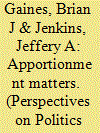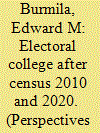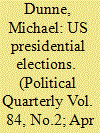| Srl | Item |
| 1 |
ID:
100849


|
|
|
|
|
| Publication |
2009.
|
| Summary/Abstract |
The 2000 presidential election made various electoral institutions-from ballot format to voting mechanisms-suddenly prominent in public debate. One institution that garnered little attention, but nonetheless affected the outcome, was apportionment. A few commentators, looking ahead to 2004, noticed that Bush would have won more comfortably had the apportionment based on the 2000 census already been in place for the 2000 election. Little attention, however, was paid to the method by which 1990 census data were used to generate the 1992-2000 apportionment, even though there are many ways to perform that allocation, the United States has used different methods over its history, and the precise algorithm turned out, in this instance, to matter. More generally, previous discussions of apportionment methods have neglected the point that allocation to states of US House seats simultaneously determines Electoral College weights. Since the Electoral College has built-in biases favoring small states, an apportionment method that partially offsets this bias might be justifiable. We revisit some criteria by which one might prefer one apportionment rule to another, in light of this double duty.
|
|
|
|
|
|
|
|
|
|
|
|
|
|
|
|
| 2 |
ID:
100848


|
|
|
|
|
| Publication |
2009.
|
| Summary/Abstract |
The combined effects of an aging population, domestic migration, and the geographically heterogeneous effects of foreign immigration are producing politically significant changes in the distribution of the American population. Using statistical projections of state populations in the 2010 and 2020 US Censuses combined with statewide estimates of the normal vote based on the last five presidential elections (1992-2008), I show that by 2024 Republican presidential candidates will receive a net benefit of at least eight electoral votes due to the declining population of the Northeast and upper Midwest relative to the rapidly-growing Sun Belt. Democratic presidential candidates will find it increasingly difficult to win elections without having some success in the South and Southwest as Barack Obama did in 2008 but many previous candidates failed to do. While migration will also benefit some solid Democratic states such as California, on balance Republican presidential candidates are poised to benefit from the status of Sun Belt states as magnets for both foreign immigration and domestic migration from a retirement cohort of unprecedented size.
|
|
|
|
|
|
|
|
|
|
|
|
|
|
|
|
| 3 |
ID:
092556


|
|
|
|
|
| Publication |
2009.
|
| Summary/Abstract |
Compared to the popular vote, the Electoral College magnifies the perception of the winner's margin of victory. In this analysis, a method of quantifying the magnitude of the advantage given to the winner due to the Electoral College's two electoral vote add-on and winner-take-all methodologies is presented. Using the electoral vote distribution that was present in the 2000 U.S. presidential election, we analyzed one million random two-candidate simulated elections. The results show that the net effect of the Electoral College is to give the winning candidate an average 29.45 electoral vote advantage per election due to the winner-take-all methodology. This winner's advantage includes an average 0.42 electoral vote advantage given to the winner per election due to the two electoral vote add-on.
|
|
|
|
|
|
|
|
|
|
|
|
|
|
|
|
| 4 |
ID:
089341


|
|
|
|
|
| Publication |
2009.
|
| Summary/Abstract |
Emily Jane Charnock, James A. McCann, and Kathryn Dunn Tenpas examine patterns of presidential travel since the Eisenhower years, focusing on the factors that prompt visits to particular states during the first term. The authors argue that electoral considerations are becoming increasingly relevant as presidents decide where and when to travel.
|
|
|
|
|
|
|
|
|
|
|
|
|
|
|
|
| 5 |
ID:
089423


|
|
|
| 6 |
ID:
122488


|
|
|
|
|
| Publication |
2013.
|
| Summary/Abstract |
The system for electing the President of the United States remains essentially as it was prescribed in the Federal Constitution drafted in 1787. The individual 50 states (plus the District of Columbia) are accorded a number of votes in the (so-called) Electoral College; each state's Electoral College vote is then attributed to the candidate gaining a plurality (most) of the popular vote in that state; and the candidate with a majority (50% + 1) of these aggregated Electoral College votes is declared the incoming president. What has changed have been the methods of nominating the candidates, chief of which are the political parties from the nineteenth century with their stage-managed quadrennial conventions and the primary/caucus campaigns from the twentieth century which precede and now determine the formal nomination. President Obama's 2012 re-election campaign showed both the crucial importance of the much-maligned Electoral College in winning the presidency and the demographic divisions hidden in the larger American political landscape.
|
|
|
|
|
|
|
|
|
|
|
|
|
|
|
|